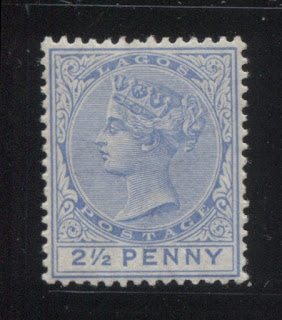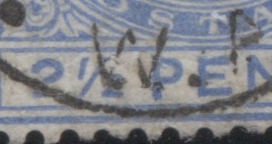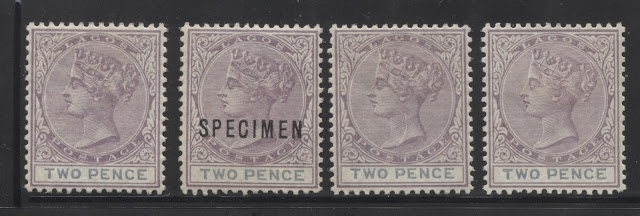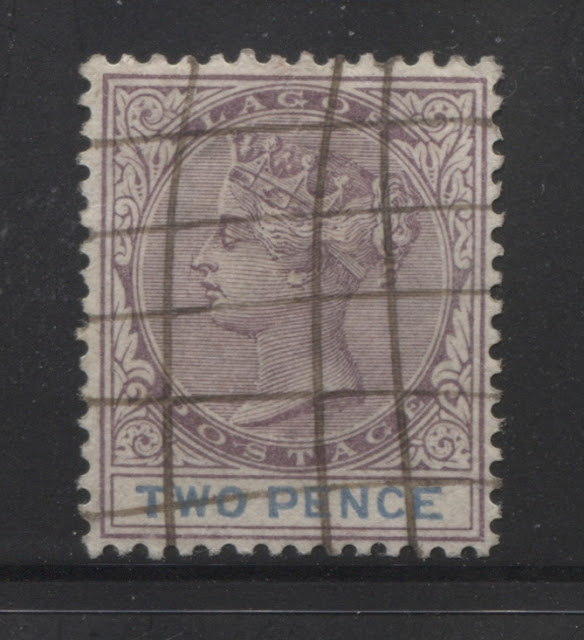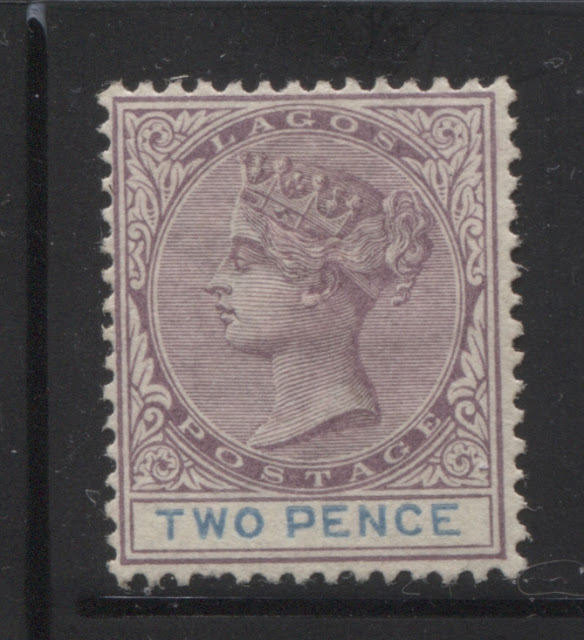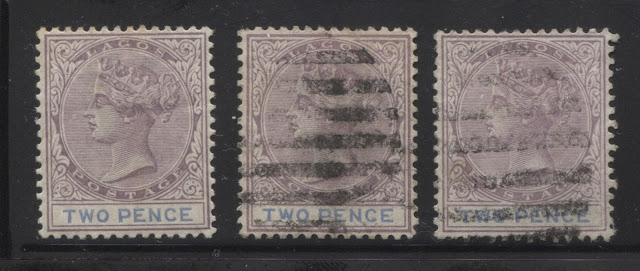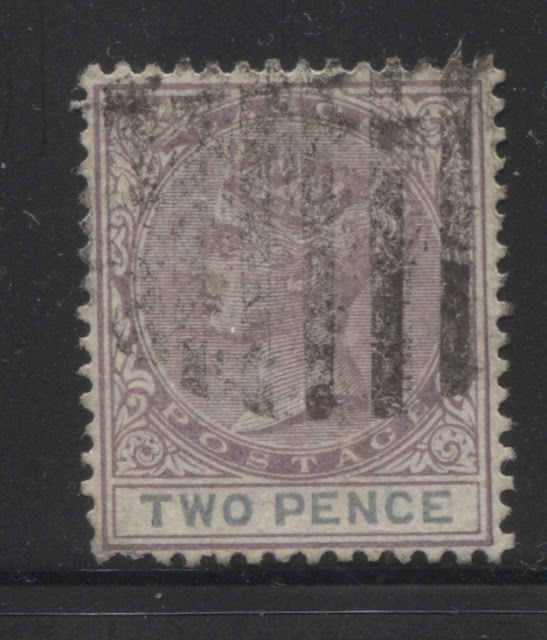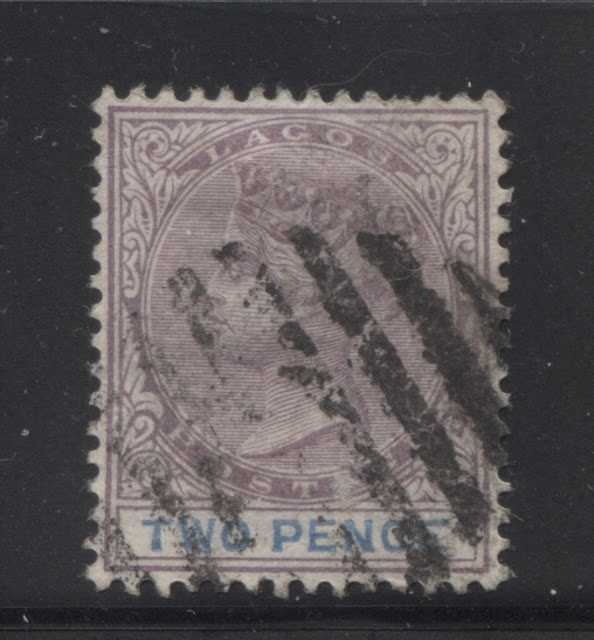Today's post will conclude my coverage of the printings of the 2.5d ultramarine, and will start looking at the 2d lilac and blue. The last post left off at the 37th printing of the 2.5d. The stamp was first issued in April 1891 and was printed for the last time in August 1901. This is just over 10 years. At one printing per quarter, this translates into approximately 41 printings that we would expect to see, if one printing was made each time that stamps were sent to the colony.
The last printings examined showed plate wear that is consistent with the 4th state of plate 1, which is so say that all of the detail in the hair behind the head is gone, as is most of the hair detail above the crown. The crown itself shows merging of the finer shading lines into solid masses of colour, and finally the horizontal shading lines in the portrait are of uneven thickness. There should normally have been a very worn 5th state for printings made between 1899 and 1900. However, I have not seen any such examples on this value. Instead, the next printings display all the characteristics that are consistent with the earliest states of the plate. This suggests that plate 2 was indeed used for this value, even though no record of plate 2 for this value exists. All the cancellations that are dated, show dates that are after 1900, which supports this notion as well.
In total I have identified five possible printings from this group, bringing the total number of possible identified printings for this value to 42. In this group, I have found one possible plate variety involving very slight doubling of the letters in "Penny", which I will illustrate here.
Thirty Eighth Printing
Thirty Ninth Printing
On this printing, the head plate colour is pale dull ultramarine, while the duty plate colour is almost an exact match to the dull ultramarine. I have one mint example, and four used examples, three of which are type A, and one of which is the scarcer type B. All of the cancellations are either Abeokuta, Lagos, or Ibadan, and all are dated between June 4, 1901 and April 4, 1904.
It is on this printing that the first of two possible constant varieties involving doubling of the duty plate numbers and letters appears. The third stamp from the left shows the start of a second impression of the top of the "2" and the bottom of the "1" of "1/2", right above the top of these numerals. This is not a common variety and was not seen at all on any of the earlier printings. You can see the variety in the following scan:
You can just make out the dot above the "1" and the shadow of a curved line above the top of the larger "2".
Fortieth Printing
Forty First Printing
Forty Second Printing
On this printing, the head plate is dull ultramarine, while the duty plate colour is closest to Gibbons's ultramarine. I do not have any mint examples, but I do have six used examples, four of which are type A, and two of which are type B. All of the cancellations are either Lagos or Ibadan, and all are dated between September 16, 1901 and December 9, 1903.
This concludes my examination of the printings of this value. Next up is the 2d lilac and blue.
The 2d Lilac and Blue
This stamp exhibits many shades of both the head and duty plate. The lilac of the more common later printings tends to be either reddish, greyish or pale, while on the early printings, which are also much scarcer, it tends to be quite deep and brownish. The duty plate exhibits the most variation, with the early printings being in either deep blues, cobalt blues or grey-blues, which progresses to royal blues and deep ultramarines, until the more common late printings are usually shades of ultramarine.
In total. 448.800 were sent out to the colony, with the number of remainders destroyed being a staggering 244,260, more than any other value. This tends to suggest that either this was not a very popular value, or that the majority of the remainders come from the last one or two printings. Given how very prevalent the more common ultramarine shades are, I would venture to suggest that like the 1d and 1/2d stamps, the bulk of the total printing comes from the last one or two printings, with the remainder being spread among the earlier to mid-period printings. The first printings were sent in March 1887 and the last printings were made and sent out in August 1901. This represents 58 calendar quarters in which it is possible that separate printings could have been made, through it seems highly unlikely to me that this many printings were actually made. My initial sort of the mint and used examples that I have suggested to me that there were a maximum of 45 printings.
There are a number of constant plate flaws on this value that first surface on the earlier printings of the 2d value, some of which originated with the very first printings back in 1874. Many of those occur on printings in this colour and will be shown in the subsequent posts detailing the printings of this value.
Most of the early printings of this value prior to 1895 in used condition are cancelled with either the 8-bar or 9-bar oval killer. However, after 1895, more and more of the used stamps are cancelled with Lagos CDS cancels, until nearly all of the used examples after 1897 are cancelled in this manner.
This stamp seems to follow the usual progression of plate wear from the early state of the plate, in which nearly all the detail of the hair and crown is clear and visible, to the last state (the 5th state) in which almost no detail is visible in the hair. Most of the stamps that I looked at dated between 1900 and 1903, appeared to be from this late state. So it does not appear that plate 2 was used for this value, which is consistent with the fact that all recorded printings are from plate 1.
Group 1 - Early Printings From the First State of the Plate - Printings 1-10 - March 1887 to About September 1889.
Generally, all of these printings will show full detail in all the Queen's hair, including the back of the head, both above and below the diagonal ribbon, as well as at the top of the head above the crown. The jewels of the crown itself will all be clear and distinct, with no merging at all of the horizontal shading lines in the bands of the crown. Due to uneven wear of the plate, a few examples in the sheet, may show very slight merging at the top of the hair, or at the back of the head, however, all the other detail will be clear, and the horizontal shading lines of the medallion will, in all cases, be of uniform thickness and evenly spaced apart.
I have identified a total of ten printings that generally meet these characteristics, all of which show an array of different head plate and duty plate shades. The remainder of this post will examine these in detail.
First Printing
On this printing the head plate colour is very close to Gibbons's reddish lilac, but is just a touch duller. The duty plate colour is closest to Gibbons's grey-blue, but is much paler. So I would classify the colour as pale grey-blue.
I have four mint examples as shown above, including one specimen overprint without gum.
Second Printing
Third Printing
The head plate colour of this printing is closest to Gibbons's deep dull purple, but is just a little bit brighter. The duty plate colour is closest to Gibbons's dull blue, but perhaps just a bit lighter. I only have the used example shown above, with an interesting cross-hatched manuscript cancellation. This is one of the only stamps that I have of Lagos that was cancelled in pen, as this was not a very common means of cancelling stamps in Lagos.
Fourth Printing
On this printing, the head plate colour is similar to the third printing, but brighter. It is actually close to what plum would be if it were lighter, so I think pale, or light plum is the colour. The duty plate colour is very similar to the third printing, but just a touch deeper and less greyish. I'd still say that it is a variant of dull blue though.
I have one mint example as shown in the scan above.
Fifth Printing
Like the first printing above, this printing also has a head plate colour that is closest to Gibbons's reddish lilac, with the colour, once again, being duller. The duty plate colour is an almost exact match to Gibbons's grey blue.
For this printing, I have one mint example, and two used examples, both of which are canceled with a strike of an 8-bar oval obliterator.
Sixth Printing
Seventh Printing
The head plate colour of this printing is also dull reddish lilac. The duty plate colour of this printing is very close to Gibbons's cobalt shade, but is just a touch duller. I have no mint examples and only three used examples as shown above. The cancellation on the first stamp appears to be a 9-bar oval, based on the narrow, widely spaced bars. The other two stamps appear to be canceled with 8-bar ovals.
Eighth Printing
The head plate colour on this printing is an almost perfect match to Gibbons's reddish lilac. The duty plate colour is closest to Gibbons's basic blue shade, but is just a touch paler, and duller. I have only this single, scuffed used example, which appears to be cancelled with an 8-bar oval obliterator.
Ninth Printing
Tenth Printing
The last printings examined showed plate wear that is consistent with the 4th state of plate 1, which is so say that all of the detail in the hair behind the head is gone, as is most of the hair detail above the crown. The crown itself shows merging of the finer shading lines into solid masses of colour, and finally the horizontal shading lines in the portrait are of uneven thickness. There should normally have been a very worn 5th state for printings made between 1899 and 1900. However, I have not seen any such examples on this value. Instead, the next printings display all the characteristics that are consistent with the earliest states of the plate. This suggests that plate 2 was indeed used for this value, even though no record of plate 2 for this value exists. All the cancellations that are dated, show dates that are after 1900, which supports this notion as well.
In total I have identified five possible printings from this group, bringing the total number of possible identified printings for this value to 42. In this group, I have found one possible plate variety involving very slight doubling of the letters in "Penny", which I will illustrate here.
Thirty Eighth Printing
This is one of the two printings of this group in which the head plate colour and the duty plate colour are the same: deep cobalt. I have only one mint example, as shown above, and it is Type A.
Thirty Ninth Printing
On this printing, the head plate colour is pale dull ultramarine, while the duty plate colour is almost an exact match to the dull ultramarine. I have one mint example, and four used examples, three of which are type A, and one of which is the scarcer type B. All of the cancellations are either Abeokuta, Lagos, or Ibadan, and all are dated between June 4, 1901 and April 4, 1904.
It is on this printing that the first of two possible constant varieties involving doubling of the duty plate numbers and letters appears. The third stamp from the left shows the start of a second impression of the top of the "2" and the bottom of the "1" of "1/2", right above the top of these numerals. This is not a common variety and was not seen at all on any of the earlier printings. You can see the variety in the following scan:
You can just make out the dot above the "1" and the shadow of a curved line above the top of the larger "2".
Fortieth Printing
Although the middle stamp is slightly affected by clear fading, the other two stamps do appear to be the true original colour, which is much paler than most other shades seen on this value. The head plate colour is an almost perfect match to Gibbons's cobalt shade, while the duty plate colour is royal blue.
This would appear to be a very distinct and scarce shade, which is quite distinct. I do not have any mint examples, but I do have three used examples, all canceled with either Lagos, or Ibadan CDS cancels dated between January 19, 1903 and August 25, 1904. This is the latest group of dates that I have seen for this value, which suggests to me that these are from the very last printing.
Forty First Printing
This is the second of this group of printings to have the same head plate and duty plate colours and is also the second to show traces of doubling in the letters of the duty plate. The colour is again very distinct and somewhat troublesome: it is too bright and light to be the bright blue, but it is too deep to be cobalt, or even deep cobalt. I would say however, that if one took the cobalt swatch on the colour key and made it both deeper, and slightly brighter, then this is the shade, that I would imagine that would result. Thus I am naming this as the deep, bright cobalt shade. I have no mint examples, and only the used example shown above, canceled with a June 2, 1902 Lagos CDS cancel.
The used example I have here also shows a partial doubling of the "PEN" of "Penny"
If you look at the above scan, you can just make out some extra colour at the very top of the "P" at the left, along the top bar of the "E" and right at the top left of the "N". These are partial extra impressions of these letters.
Forty Second Printing
On this printing, the head plate is dull ultramarine, while the duty plate colour is closest to Gibbons's ultramarine. I do not have any mint examples, but I do have six used examples, four of which are type A, and two of which are type B. All of the cancellations are either Lagos or Ibadan, and all are dated between September 16, 1901 and December 9, 1903.
This concludes my examination of the printings of this value. Next up is the 2d lilac and blue.
The 2d Lilac and Blue
This stamp exhibits many shades of both the head and duty plate. The lilac of the more common later printings tends to be either reddish, greyish or pale, while on the early printings, which are also much scarcer, it tends to be quite deep and brownish. The duty plate exhibits the most variation, with the early printings being in either deep blues, cobalt blues or grey-blues, which progresses to royal blues and deep ultramarines, until the more common late printings are usually shades of ultramarine.
In total. 448.800 were sent out to the colony, with the number of remainders destroyed being a staggering 244,260, more than any other value. This tends to suggest that either this was not a very popular value, or that the majority of the remainders come from the last one or two printings. Given how very prevalent the more common ultramarine shades are, I would venture to suggest that like the 1d and 1/2d stamps, the bulk of the total printing comes from the last one or two printings, with the remainder being spread among the earlier to mid-period printings. The first printings were sent in March 1887 and the last printings were made and sent out in August 1901. This represents 58 calendar quarters in which it is possible that separate printings could have been made, through it seems highly unlikely to me that this many printings were actually made. My initial sort of the mint and used examples that I have suggested to me that there were a maximum of 45 printings.
There are a number of constant plate flaws on this value that first surface on the earlier printings of the 2d value, some of which originated with the very first printings back in 1874. Many of those occur on printings in this colour and will be shown in the subsequent posts detailing the printings of this value.
Most of the early printings of this value prior to 1895 in used condition are cancelled with either the 8-bar or 9-bar oval killer. However, after 1895, more and more of the used stamps are cancelled with Lagos CDS cancels, until nearly all of the used examples after 1897 are cancelled in this manner.
This stamp seems to follow the usual progression of plate wear from the early state of the plate, in which nearly all the detail of the hair and crown is clear and visible, to the last state (the 5th state) in which almost no detail is visible in the hair. Most of the stamps that I looked at dated between 1900 and 1903, appeared to be from this late state. So it does not appear that plate 2 was used for this value, which is consistent with the fact that all recorded printings are from plate 1.
Group 1 - Early Printings From the First State of the Plate - Printings 1-10 - March 1887 to About September 1889.
Generally, all of these printings will show full detail in all the Queen's hair, including the back of the head, both above and below the diagonal ribbon, as well as at the top of the head above the crown. The jewels of the crown itself will all be clear and distinct, with no merging at all of the horizontal shading lines in the bands of the crown. Due to uneven wear of the plate, a few examples in the sheet, may show very slight merging at the top of the hair, or at the back of the head, however, all the other detail will be clear, and the horizontal shading lines of the medallion will, in all cases, be of uniform thickness and evenly spaced apart.
I have identified a total of ten printings that generally meet these characteristics, all of which show an array of different head plate and duty plate shades. The remainder of this post will examine these in detail.
First Printing
On this printing the head plate colour is very close to Gibbons's reddish lilac, but is just a touch duller. The duty plate colour is closest to Gibbons's grey-blue, but is much paler. So I would classify the colour as pale grey-blue.
I have four mint examples as shown above, including one specimen overprint without gum.
Second Printing
The head plate colour on this printing is almost an exact match to Gibbons's reddish lilac. The duty plate colour is closest to Gibbons's deep dull blue, but without the greenish tinge that the Gibbons swatch shows.
I only have one mint example, but I do have three used examples, one of which is cancelled with a lovely strike of a September 9, 1889 Lagos CDS, which the earliest CDS date that I have seen on this value, bu a margin of nearly six years. The other two used examples appear to be cancelled with 8-bar oval obliterators.
Third Printing
The head plate colour of this printing is closest to Gibbons's deep dull purple, but is just a little bit brighter. The duty plate colour is closest to Gibbons's dull blue, but perhaps just a bit lighter. I only have the used example shown above, with an interesting cross-hatched manuscript cancellation. This is one of the only stamps that I have of Lagos that was cancelled in pen, as this was not a very common means of cancelling stamps in Lagos.
Fourth Printing
On this printing, the head plate colour is similar to the third printing, but brighter. It is actually close to what plum would be if it were lighter, so I think pale, or light plum is the colour. The duty plate colour is very similar to the third printing, but just a touch deeper and less greyish. I'd still say that it is a variant of dull blue though.
I have one mint example as shown in the scan above.
Fifth Printing
Like the first printing above, this printing also has a head plate colour that is closest to Gibbons's reddish lilac, with the colour, once again, being duller. The duty plate colour is an almost exact match to Gibbons's grey blue.
For this printing, I have one mint example, and two used examples, both of which are canceled with a strike of an 8-bar oval obliterator.
Sixth Printing
The head plate colour of this printing is closest to Gibbons's reddish lilac, but dull. So I have named the frame colour of this printing dull reddish lilac. The duty plate colour is closest to Gibbons's slate blue, but like the first printing, the colour is paler than the Gibbons swatch. So I would call the duty plate colour in this case pale slate blue.
I have only the used example shown above, which is cancelled with a strike of an 8-bar oval obliterator.
Seventh Printing
The head plate colour of this printing is also dull reddish lilac. The duty plate colour of this printing is very close to Gibbons's cobalt shade, but is just a touch duller. I have no mint examples and only three used examples as shown above. The cancellation on the first stamp appears to be a 9-bar oval, based on the narrow, widely spaced bars. The other two stamps appear to be canceled with 8-bar ovals.
Eighth Printing
The head plate colour on this printing is an almost perfect match to Gibbons's reddish lilac. The duty plate colour is closest to Gibbons's basic blue shade, but is just a touch paler, and duller. I have only this single, scuffed used example, which appears to be cancelled with an 8-bar oval obliterator.
Ninth Printing
On this printing, the head plate colour is closest to Gibbons's dull purple, being an almost exact match. The duty plate colour once again closest to Gibbons's deep dull blue, but without the greenish tinge that the Gibbons swatch has. I have no mint examples of this printing, and only the above two used examples, both of which are cancelled with 8-bar oval obliterators.
Tenth Printing
The head plate colour of this printing is again, an almost exact match to Gibbons's reddish lilac. The duty plate colour is an almost perfect match to Gibbons's blue shade. I have six mint examples of this printing, five of which are shown here. I also have four used examples, all of which appear to be cancelled with 8-bar ovals, through the cancellation on the left stamp might be a 9-bar oval.
This takes us to the end of my examination of the first 10 printings of this value, which as I said should have been issued prior to 1890. Interestingly, there has been no appearance of ultramarine for a duty plate colour as yet. All of these early printings used shades of blue, dull blue, grey blue or slate blue for the printing of the duty plate. All of these are much, much scarcer than the later printings, and as such are worth much more than the basic Gibbons price, which is for the most common printings.
Next week I will look at the printings made from the first state of the plate in which wear first appears.


